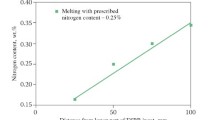Conclusions
-
1.
The nonuniform effect of average defect density and average stress level on the corrosion resistance of steel is due to evolution of a substructure and connected with it the nonuniform dependence of local internal stresses.
-
2.
A new test procedure for corrosion-mechanical strength provides quantitative estimates of the test results.
-
3.
Hot-working may be used in order to prepare articles intended for operation in corrosive media with high stresses.
Similar content being viewed by others
Literature cited
V. P. Pogodin, V. L. Bogoyavlenskii, and V. P. Sentyurev, Intercrystalline Corrosion and Corrosion Cracking of Stainless Steels in Aqueous Media [in Russian], Metallurgiya, Moscow (1970).
S. D. Bogolyubskii, "Ways of improving the corrosion resistance of metal", Stal', No. 2, 145 (1972).
N. D. Tomashov and G. P. Chernov, "Corrosion and corrosion-resistant alloys", in: Successes of Modern Physical Metallurgy [in Russian], Metallurgiya, Moscow (1973).
M. G. Lozinskii, E. N. Sokolkov, N. V. Varli, and Yu. A. Skakov, "Effect of high-temperature mechanical treatment on the fine crystalline structure of austenitic steels and alloys", Fiz. Met. Metalloved.,13 No. 1, 137–143 (1962).
S. Z. Bokshtein, S. T. Kishkin, M. G. Lozinskii, and E. N. Sokolkov, "Thermomechanical treatment of chromium-nickel-manganese austenitic steel", Izv. Akad. Nauk SSSR, Metall. Toplivo, No. 2, 15–21 (1962).
A. A. Popov, "Effect of working on precipitation of M23C6 carbide in austenitic steel", Fiz. Met. Metalloved.,38, No. 2, 337–342 (1974).
Ko Soeno Chigasaki, J. Iron and Steel Inst. Jpn.,64, No. 9, 1369 (1978).
Cihal, Kovove Mater., No. 2, 214 (1975).
A. A. Vol, A. Ya. Kipnis, and N. F. Mikhailova, "Nonuniform dependence of the reaction capacity of metals on average defect density", in: Proc. All-Union Conf. on Kinetics and Mechanism of Chemical Reactions in Solids, Part 1, Novosibirsk (1977).
V. V. Rybin, A. S. Rubtsov, and G. E. Kodzhaspirov, Fiz. Met. Metalloved.,58, No. 4, 774–781 (1984).
V. Ya. Gol'dshtein, V. I. Zav'yalova, and A. L. Piskunova, "Effect of structure on the tendency toward ICC of stainless steel 08Kh18N10T", Metalloved. Term. Obrab. Met., No. 6, 60–63 (1981).
USSR Inventor's Certificate No. 1,146,583, MKI GOLN17/00, "Method for estimating the corrosion-mechanical strength of structural metallic materials in a corrosive medium".
E. É. Glikman, Yu. V. Goryunov, V. M. Demin, and K. Yu. Sarychev, "Role of the structure of the interphase surface of crystal-melts in development of the Rebinder effect in metals", Dokl. Akad. Nauk SSSR, Ser. Fiz. Khim.,227, No. 3, 645–648 (1976).
Additional information
Translated from Metallovedenie i Termicheskaya Obrabotka Metallov, No. 12, pp. 24–27, December, 1989.
Rights and permissions
About this article
Cite this article
Kodzhaspirov, G.E., Vol, A.A. & Stepanov, Y.P. Effect of hot working on corrosion-resistant steel 08Kh18N10T. Met Sci Heat Treat 31, 888–891 (1989). https://doi.org/10.1007/BF00798231
Issue Date:
DOI: https://doi.org/10.1007/BF00798231




